- Science Castle Research Fund
- Announcements for middle and high school students
- Information for Teachers
- Digest of Oral Presentations
- Research Tips
I want to elucidate the beautiful charm of tussocks through research! Mr. Komatsu's Challenge [Science Castle 2023 Kanto Digest].
2024.05.30
Here is a digest of the Science Castle, an academic conference for junior and senior high school students where the next generation of researchers is in full swing, as well as the excitement of the event. In this issue, we report on the presentation by Kazuhiro Komatsu (junior high school student at junior high school attached to Suwa Seiryo High School in Nagano Prefecture), who received the Nippon Ham Prize for his oral presentation at the Science Castle 2023 Kanto Conference!
Affiliation and grade are as of the time of the announcement.
Enchanted by the Mystery of the Tussock
Hello everyone. My name is Kazuhiro Komatsu, and I am from Nagano Prefecture. I have developed a "technique for quantifying the opening and closing status of tussock moths" using deep learning to elucidate the unique characteristics of tussock moths, i.e., their sleeping movements.
First of all, let me introduce my research motivation, the source of my passion. Please take a look at this video (video will be played at the venue). This is a shot of a tussock opening its leaves in response to light. It is a powerful, cool, and beautiful movement. I was so fascinated by the tussock that I said to myself, "I want to unravel the mystery! Let's do research!" I have been conducting my research.
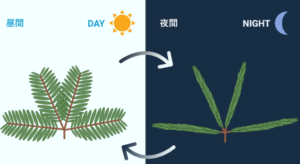
The sleep-disturbing movement of tress is the movement of opening leaves during the day and closing leaves at night, and is controlled by the cyclic increase and decrease of two substances, wakefulness substance and sleep-disturbing substance. In other words, during the day when the leaves are open, there is more stimulant substance, and during the night when the leaves are closed, there is more sedentary substance.
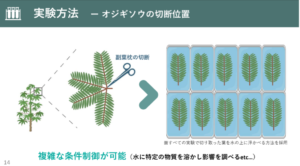
Only you in the world! Osotspa can be observed 24 hours a day.
There are three points of focus in the research. First, the experimental environment was set up indoors, allowing for complete control of conditions and quantitative experiments; second, we employed an experimental method in which the leaves of the tress were cut and floated on water. You may have wondered, "Does tress really go through a sleep movement while floating on water?" I think you may have wondered "Does tinsel really go into sleep exercise while floating on water? The tergum performs an open-and-close motion even when floated on the water. Therefore, in order to enable complex condition control, we adopted this experimental method in this study.
The third point of concern is the construction and implementation of the model. This is a very important part of this research, which is how to evaluate the degree of opening of the tussock. Until last year, we had been visually judging the degree of leaf opening by saying, "It's about 170 degrees, isn't it? However, to do this for all the leaves, we had to make a visual judgment of the degree of leaf opening. However, it is very labor intensive and not at all scientific to do this for all the leaves. Therefore, this year, I developed a tool to quantify the opening and closing of the leaves for 24 hours.
The first step in the technology process is to take photos automatically for 24 hours, detect the tussock leaves in the photos, and quantify the degree of opening. For the automatic photography, the camera here takes a photo once every five minutes. For the leaf detection technology, we used the Yolov8 model to detect the leaves of the tussock using the object detection method.
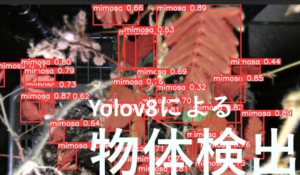
Finally, for the technology to quantify the degree of opening, I built a model that calculates the degree of opening when given an image of a tussock by training a portion of an existing neural network to match the tussock. In this way, I have developed a technology that can quantify the opening of a tussock for 24 hours.
Until now, in previous studies, the opening status of tussock plants has been determined visually. Therefore, I am very proud that I am the only person in the world who can watch the opening and closing status 24 hours a day.
The tussock opens its leaves before the light begins to hit it!
Here are the results. First of all, this is the result of the same 12-hour light/dark cycle for the tussock, which was grown indoors with a 12-hour light/dark cycle using a plant growth light. The vertical axis of the graph is the degree of opening and closing, and the horizontal axis is the time axis. Looking at the data, there are two interesting results. The first is that "tress open their leaves before the light starts to hit them. Second, the fact that there are individuals with two different timing of opening indicates that "the arousal substance of tress may have two peaks and increase or decrease". This is the reason. This would allow the leaf opening to be smaller during the hours of intense light, protecting the chloroplasts from strong sunlight.
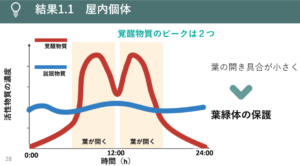
The next experiment was conducted by exposing the tress to light under the same conditions as before, with the tress grown outdoors by natural light. The results showed no response at all. Where and under what conditions did this difference in response occur? We found out by putting together the indoor and outdoor conditions. There was a big difference in light intensity. This suggests that the amount of active substance released by the tussock increased or decreased according to the intensity of light, and that the tussock that released active substances in response to strong outdoor light was unable to respond to weak indoor light.
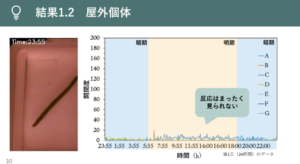
Experiments Revealed! Hints of Sleeping Movement in the Pteridophyllum japonicum
Finally, we experimented with light/dark cycles. We used a plant that had been grown indoors with a light/dark cycle of 12 hours and exposed it to light at various light/dark cycles. The hypothesis was that the leaves would open for 12 hours regardless of the length of light. Individuals that were not exposed to any light at all responded slightly, but basically, they opened their leaves only during the time they were exposed to light.
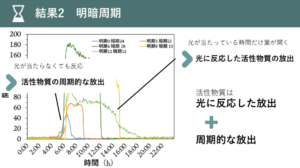
In fact, the leaves of the potted tussock will remain open for 12 hours regardless of the light/dark cycle or the amount of time the plant is exposed to light. So how did this difference in response come about? We believe that it is due to the ion channels on the surface of the leaves and the fact that more arousal substances are released into the water from the cut surfaces of the pots, resulting in an absolute decrease in the amount of arousal substances. In addition, since there are conditions under which the plant responds even in the absence of light, and since the leaves open only during periods of light exposure, we believe that the active substances of the tress may be released in two ways: "light-responsive release" and "periodic release".
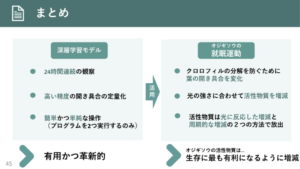
As for future prospects, we actually attempted to extract the active substance of tress this year from the leaves of tress, but were not successful. Therefore, next year, we would like to continue this experiment as well as organically synthesize and extract the active substance from the ojigisou plant to elucidate its sleep-disturbing movements.
Questions from the Jury
Naoki Morishita (Nippon Ham Corporation):
Thank you for your very interesting presentation. I would like to ask you about the quantitative model that you have created. I think it must be quite difficult to develop a technique to successfully detect overlapping leaves. We are actually doing the same thing with pigs, but pigs also have overlapping leaves (like tussocks). Can you tell us what you are doing in this area?
Kazuhiro Komatsu:
At first we were going to experiment with the leaves in pots, but as you said, it was very difficult to quantify them, so we floated them on top of water so that they did not overlap, which enabled us to detect the leaves. From next year, we hope to be able to somehow detect the overlapping leaves of tress in pots, and to quantify tress in pots as well.
Tetsushi Nishiyama (Liverness Corporation):
Thank you for an enjoyable presentation. I would like to ask you about your last experiment, and I was particularly interested in the fact that you responded without brightening the light at all. It made me wonder, "How did the tussock remember the time?" Just to confirm the whole situation, how many times do the leaves open and close, in a 12-hour cycle, and then open again after 12 hours? I would also like to ask about the conditions prior to doing this experiment.
Kazuhiro Komatsu
As for the light conditions, we basically increase or decrease the active substance by exposing it to light with a light/dark cycle of 12 hours. Therefore, I wonder if it is reacting even if it is not illuminated because of the cyclic increase/decrease of active substances that occurs.As for whether this reaction repeats all the time, under these conditions, the same reaction is seen on the second and third days.
Tetsushi Nishiyama (Liverness Corporation):
(Does (the tussock) remember the cycle?
Kazuhiro Komatsu:
I wonder if the tussock is creating a cycle to release active substances in order to perform photosynthesis more efficiently. It is as if it remembers when to release the active substance.
Tetsushi Nishiyama (Liverness Corporation):
We encourage you to try the next experiment to learn other cycles, such as 15 hours.
Kazuhiro Komatsu:
Actually, I once exposed it to light for 24 hours in pod conditions. At that time, the tardigrades stopped doing cyclic movements at all. I am wondering if it is possible to adjust the length of the sleep movement by artificially changing the length of light exposure, and I would definitely like to try this next year and beyond.
(*Honorifics omitted)
